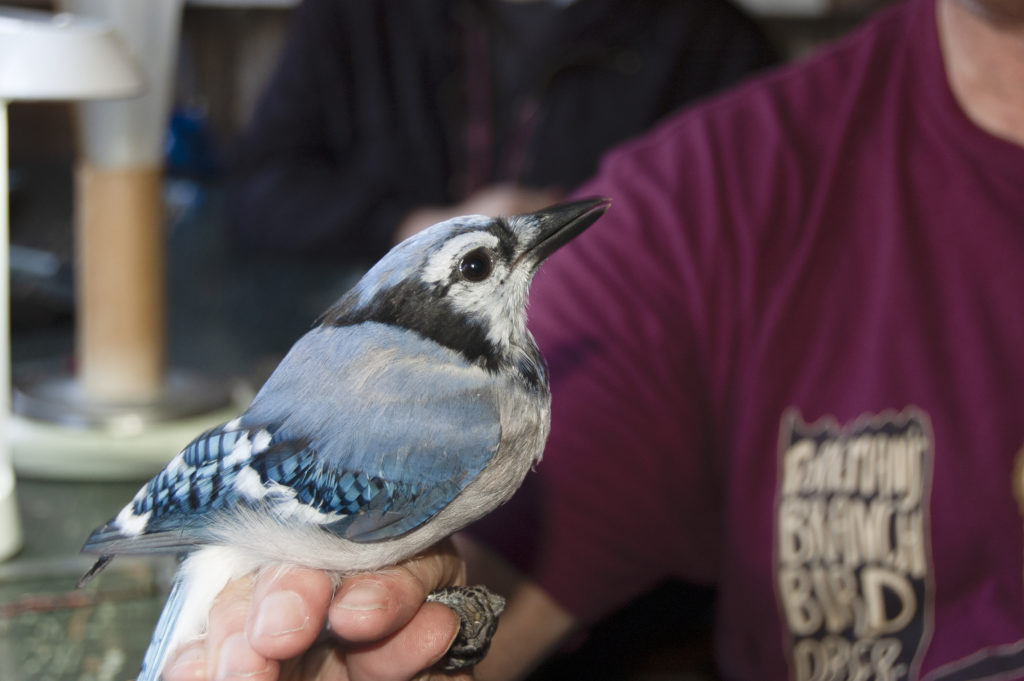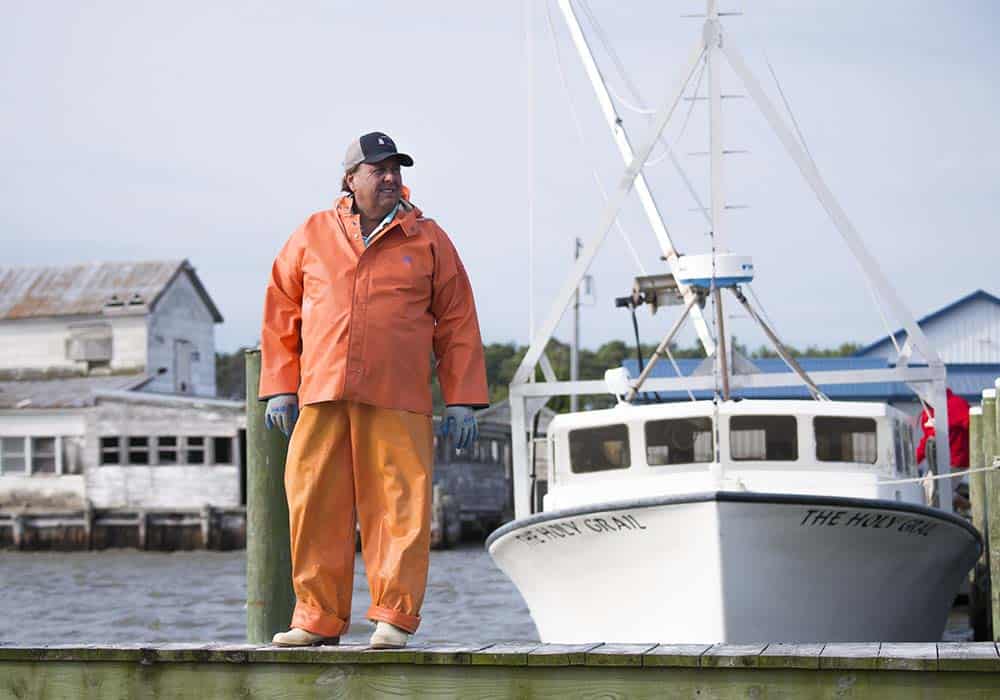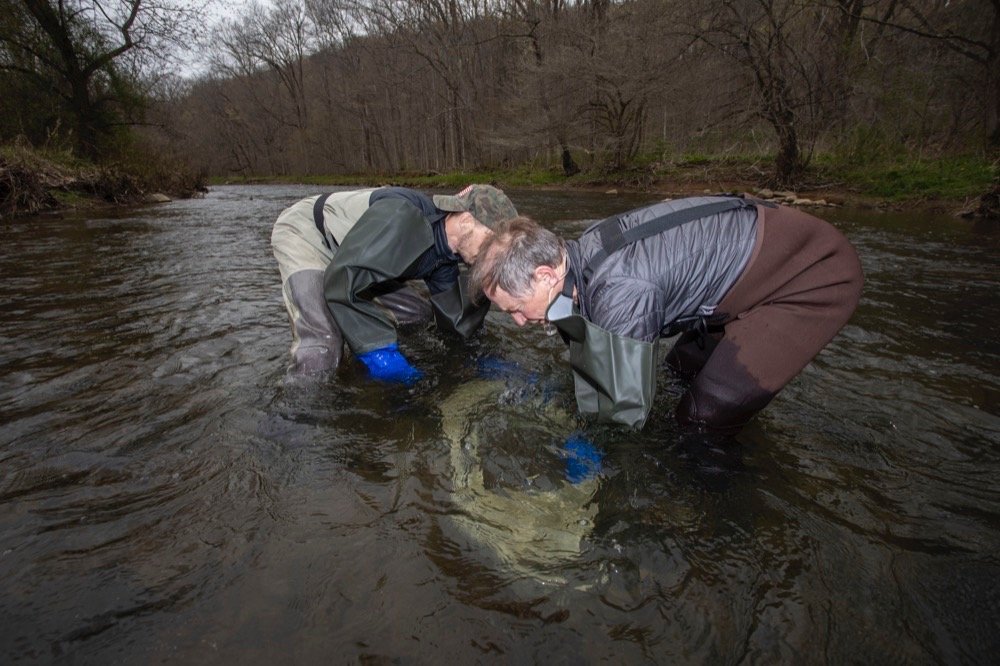100 years of bird-banding
The little song sparrow doesn’t know it, but it may become a bellwether for its species. Feet up, head gently cradled between Jim Gruber’s index and middle fingers, it fusses as the bespectacled researcher crimps a tiny aluminum anklet around one of its legs.
Further avian indignity ensues. The bird’s wing is measured. Its estimated age and its gender are noted. Gruber blows softly on its breast and belly feathers to assess its fat content. Finally, he weighs the sparrow by carefully inserting it headfirst into a long plastic cone attached to a digital scale. Only after its vital statistics have been recorded does the sparrow get to resume its daily activities.
The bird’s delicate physical lasts about 60 seconds. The coded band it now carries for the rest of its days will help scientists trace its movements and habits, and discern threats to the species’ survival.
Bird banding, as practiced here at Foreman’s Branch Bird Observatory on the upper Eastern Shore, has been around for more than a century, but scientific inquiry into the mysterious ways of birds is more important than ever. Recent studies have documented in stark terms North America’s plummeting avian populations. Writing in the journal Science, researchers reported in 2019 that nearly three billion of the continent’s breeding adult birds have been lost since 1970—less than a human lifetime. “Species extinctions have defined the global biodiversity crisis, but extinction begins with loss in abundance of individuals,” the report warned.
Birds are disappearing across all habitats. Grassland birds have declined by 53 percent in the last 50 years, forest birds by 22 percent, and shorebirds by 37 percent since 1974, according to the North American Bird Conservation Initiative. Even common species such as song sparrows are down by over 30 percent.
Were it not for decades of extensive data-gathering by professional and citizen scientists, these incremental losses might have eluded detection for too long, leaving us with silent springs (as author-conservationist Rachel Carson famously warned of songbird decline) and flightless falls.
“Three billion birds gone. That tells you to focus your energy on better understanding what’s going on,” says Antonio (Tony) Celis-Murillo, director of the Bird Banding Laboratory (BBL), during an interview on BBL’s campus. Founded in 1920, the federal agency has been collecting, managing, and disseminating banding data ever since. Its records form an enduring and invaluable resource for studying bird biology, behavior, and population trends. This bottomless memory bank of bird knowledge is located in the heart of Bay country, at the Eastern Ecological Science Center, part of the U.S. Geological Survey’s Patuxent Research Refuge in Laurel, Md.
“With birds in your hand, you get to know them better and closer,” Celis-Murillo says of banders, all of whom must be permitted through his agency. “The BBL is the link between the scientists who are going to apply the science and people in the community collecting the data. Everyone who has a role in the chain of data can clearly see that they’re helping birds.”
Foreman’s Branch, part of Washington College’s 5,000-acre River and Field Campus near Chestertown, has been banding birds since 1998. It’s the only major migratory bird banding station on Maryland’s Eastern Shore. Gruber founded the station (which also conducts avian research) and serves as its director. On an unusually sultry October morning, he, field ecologist Maren Gimpel, and a small group of Washington College interns and assistants are processing birds during the station’s busy fall migration season, which stretches from August through November. On average, Foreman’s Branch bands more than 10,000 birds (representing about 120 species) in the fall, triple the bandings done during its more concentrated spring season. The station has banded nearly 350,000 birds during its existence.
The banders begin before sunrise, unfurling more than 1,200 yards of nearly invisible nylon mist netting to be hung at nets deployed in fields, woods, hedgerows, and stream banks on the property. (The station, which occupies a fraction of the college’s outdoors campus, takes its name from a tributary of the Chester River.) Seven days a week, weather permitting, they check the nets hourly from daybreak to early afternoon, carefully untangling birds caught in the gossamer-like webbing. The birds are placed in mesh drawstring bags, which are then attached to the necklace of colorful carabiners each bander wears. After the net checks—which are briskly paced—everyone returns to the banding lab, a rustic wooden shed where a landowner previously raised pheasants for hunting.
These days it’s a kitted-out biologist’s field office: shelves stacked with reference books (including thick volumes of The Birds of North America), a chalkboard for tallying bandings, a pin-studded map of the United States showing where station-banded birds were recovered, and a stash of essential supplies (Buzz Away, Itch Nix, cookies from a natural foods store that Gruber and his wife own). Business operations are conducted at a long workbench equipped with special banding pliers and a variety of BBL-issued bands, arranged by size. Inscribed on each is a unique eight- or nine-digit number and the BBL website where retrieved bands can be reported (reportband.gov).
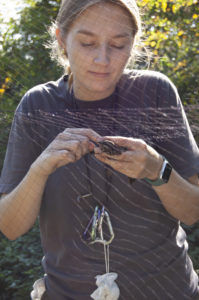
Libby Witham untangles a sparrow from a mist net.
The tiny tags unlock a trove of avian insight. In banding, even brief examinations reveal important data about the bird in hand. The amount of yellowish-orange belly fat determines whether it is migrating or not. (Birds store fat for their arduous seasonal journeys.) Ecologist Gimpel fans out a sparrow’s wing, identifying it as a juvenile by its partial complement of black-shafted feathers. A mature bird’s wing would be entirely covered with them, she says. An assistant records the band’s identification number and the bird’s biological dossier on a clipboard, information that will be submitted to the BBL database.
Data from migrating birds banded in Canada are also sent to the BBL, making the Maryland facility the world’s premier repository of scientific avian information. “It’s a very important resource, with over one hundred years of data,” director Celis-Murillo says. “We have a little more than 77 million records, and records of at least five million encounters (the term for banded birds whose information is recovered). Once you have such an amount of data you can really be clever in finding an answer to many, many questions related to ecology, pollution, biology—whatever.”
America’s first great student of birds, John James Audubon, is credited with being the first to band them. In 1804, he tied silver thread to the legs of Eastern phoebes nesting near his Pennsylvania home to see whether they’d return to their nests the following year. (Several did.) A century later, a Smithsonian Institution researcher named Paul Bartsch used a more sophisticated method to determine whether the aquatic snails he was studying were being transported by black-crowned night herons from one waterway to another. Bartsch fastened aluminum leg bands bearing the year (1902), a serial number, and the Smithsonian’s return address on 23 nestling herons to track their movements. Only one band was returned, but Bartsch continued the experiment and other researchers soon adopted his monitoring technique.
Banding became federalized with passage of the Migratory Bird Treaty Act of 1918, which prohibited killing and trafficking in protected species of migratory birds often hunted for their plumage. The BBL was established two years later. Now under the auspices of the fourth different federal agency in its history, the USGS-run facility issues all bird banding permits in the United States. It ensures applicants have a scientific reason for the banding they want to conduct and that banders have the proper and latest training for the species they wish to handle.
Applicants submit proposals to the BBL, where a four-member panel reviews them and grants or denies banding permits. “It’s ultimately all for the welfare of birds,” Celis-Murillo explains. “We’re trying to make sure the birds are going to be well handled, well treated, and that the banding science won’t harm birds.”
Bands range in size and design from the daintiest of rings for hummingbirds to beak-proof bands for hawks and other raptors inclined to remove them. They’re supplied gratis by the BBL to more than 5,000 permitted banders in the United States. Canada, which jointly supervises North American bird banding with the BBL, issues its own permits to that nation’s 1,000 to 2,000 banders.
Would-be banders receive training—some at hands-on workshops, but more commonly through apprenticeships with programs such as Foreman’s Branch’s. Director Gruber says he was just 15 years old when he began banding birds decades ago under the tutelage of an experienced bander. (Today, the BBL requires that all banders be at least 21 years old.) Among his early experiences, Gruber worked for “Operation Recovery,” the first major initiative to band large numbers of fall migrants along the Atlantic Coast.
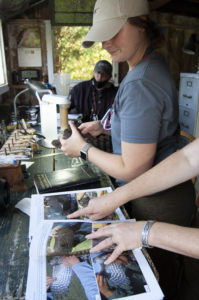
One of its lead researchers was a Maryland birding legend, Chandler S. (Chan) Robbins, a Patuxent Research Center biologist who launched the North American Breeding Bird Survey (BBS) in 1966, a pioneering annual roadside count by skilled birdwatchers. The research center still uses BBS numbers to assess songbird abundance and BBS data greatly informed the 2019 report published by Science.
Gruber’s colleague, Gimpel, has been banding birds since 2006. Leaving a government desk job, she seized an opportunity to work at a banding station on a remote island off Nova Scotia. Conditions were spartan, but Gimpel found her calling. “I realized this is basically the coolest thing that I’ve ever done,” she says.
One of Gimpel’s and Gruber’s proteges today is Washington College intern Libby Witham, a sophomore. She developed a love for birds early, she says, birding with her father at their home in New Jersey. She wants to find a job in avian research after graduating.
“That’s one challenge in bird banding is finding the experience,” Gimpel says. “We have more people who want to learn than there are jobs.” The station uses volunteers in addition to its paid interns, but only when there’s time enough time to train suitable candidates. Good hand-eye coordination, manual dexterity, and keen observational skills make for a successful bander, says Gimpel, a certified banding trainer.
In addition to gathering basic biological data, Foreman’s Branch collaborates on projects with other avian research institutions: collecting tick samples to study disease transmission, observing avian behavioral patterns to test bird-friendly glass, using tiny radio transmitters to track by satellite birds that survive building strikes.
Increasingly, the BBL is incorporating such ancillary data into its database, a boon for researchers. Currently, U.S. and Canadian banders submit records digitally via a web portal, but Celis-Murillo says one day the BBL also will have an app for that, enabling banders to input data directly from the field. Quality control is paramount. BBL computers employ filters that scan for anomalous information, flagging aberrant entries for internal review before they’re accepted.
“We have a group of biologists who have a lot of experience. They’re amazing,” Celis-Murillo says. “If one record says this is this species caught on this date in this location, they immediately say, ‘That’s two days late. That’s not normal.’ They know by the day, by the location, by the species.” The biologists work with banders to resolve discrepancies.
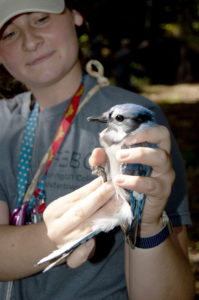
The BBL’s primary mission is bird conservation. One of its oldest (over a half century and counting) and most successful collaborations is with the U.S. Fish and Wildlife Service. Hunters are among those most likely to find and report certain species of banded birds. Data from those encounters helps the wildlife service establish hunting regulations that protect bird populations while preserving waterfowl and gamebird hunting. Wood ducks, once nearly extinct and federally protected until 1941, have recovered thanks to habitat restoration and monitoring efforts, including banding. (The River and Field Campus is among these ducks’ breeding grounds.)
But for every imperiled species rescued—wood ducks, bald eagles, whooping cranes, wild flamingos—there are many more in need of intervention. In September, federal officials declared 11 U.S. bird species extinct, officially removing them from the Endangered Species Act that sought to protect them. In Maryland, there are currently 14 bird species on the state’s endangered list. Virginia lists seven. The primary culprits are habitat loss and climate change. A recent National Audubon Society report, “Survival by Degrees,” found that two-thirds of America’s birds are threatened with extinction if global warming and sea level rise continue apace. But if temperature increases can be limited globally, the report notes, three out of four threatened species—such as whip-poor-wills, woodcocks, red-headed woodpeckers, and Eastern towhees in Maryland—can yet be saved.
“Climate change is making all scientists reassess our strategies to move forward with the science of conservation,” the BBL’s Celis-Murillo says. “As chief, I see it as a really good opportunity to revamp our activities in the lab, improve our partnerships, and evolve together.”
A bird enthusiast since he was a teenager in his native Mexico, Celis-Murillo earned degrees in biology, evolution, and environmental science. He’s been with the BBL for five years and takes a glass-half-full approach to federal budget cuts and staffing shortages that have beset his agency in recent years.
“I don’t blame our leadership because it’s not just the BBL, but across all government agencies,” he says. “I know it’s not personal. It’s not that we’re doing a bad job.” Given the challenges, however, Celis-Murillo is determined to raise the BBL’s profile as a national resource for birds in a world of peril.
“For those of us who understand all the possibilities of data,” he says, “we feel like we are sitting on a pot of gold.” He’s sharing the wealth, recently launching “Banding Without Borders,” an initiative through which the BBL can exchange ideas and methodology with banders across the globe.
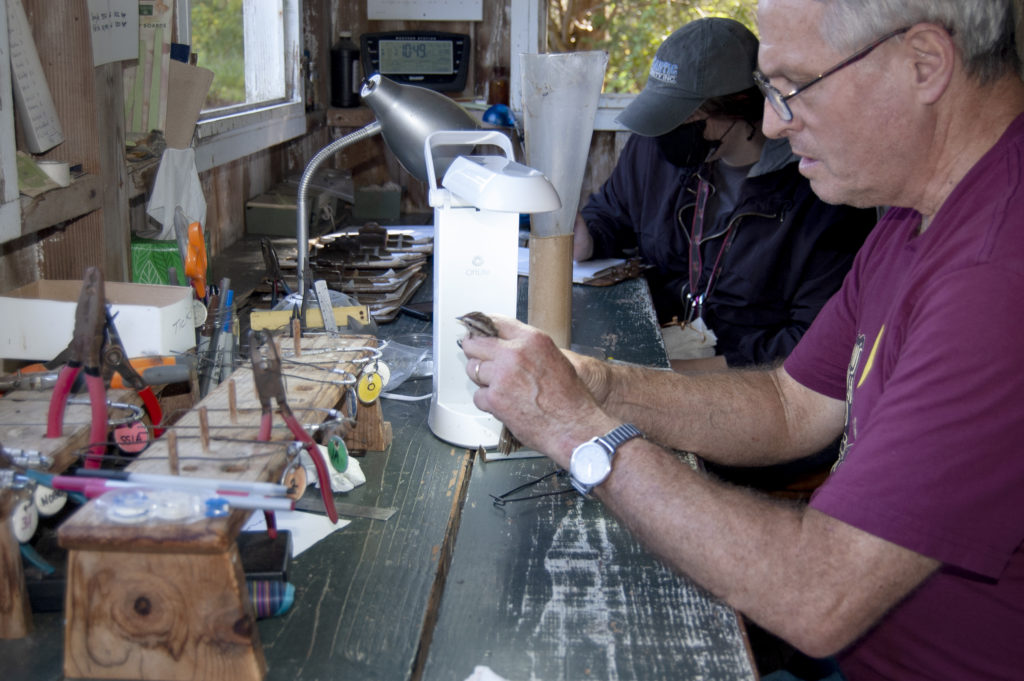
Celis-Murillo also emphasizes the agency’s historic dependency on the public. “It’s important for us to be clear that we really rely on the community science part,” he says. Citizens who report band information now receive certificates of appreciation. Celis-Murillo would like to further motivate bird lovers by opening up the dedicated banders’ portal so the public can view migration maps for backyard birds and discover where to find banding workshops and materials—anything to facilitate greater public engagement.
At Foreman’s Branch, the day’s operations wind down. The station has added to its fall tally of unusual species, which already includes, among others, a yellow-billed cuckoo in August and a whip-poor-will in September. Today’s rarity is an intergrade Northern flicker, a yellow-shafted/red-shafted hybrid.
Yet another celebrity emerges from the final net check, a sharp-shinned hawk. (On average, the station bands fewer than a dozen annually.) After recovering following 1972’s DDT ban, the sharpie population is declining again, according to the National Audubon Society. The numbered band that Chesapeake Conservation Corps member and college alum Maddy Ondo affixes on this hawk’s leg may help biologists determine what’s happening to them.
The hawk’s large yellow eyes glare as two young paparazzi banders quickly snap closeups prior to the bird’s release—a human-raptor Instagram moment that ends with a whoosh of the departing hawk’s wings. Their connection is palpable.
“Having a bird in your hand is special,” Celis-Murillo says. “I haven’t seen a picture of someone handling a bird where that person isn’t smiling. That says it all.”

